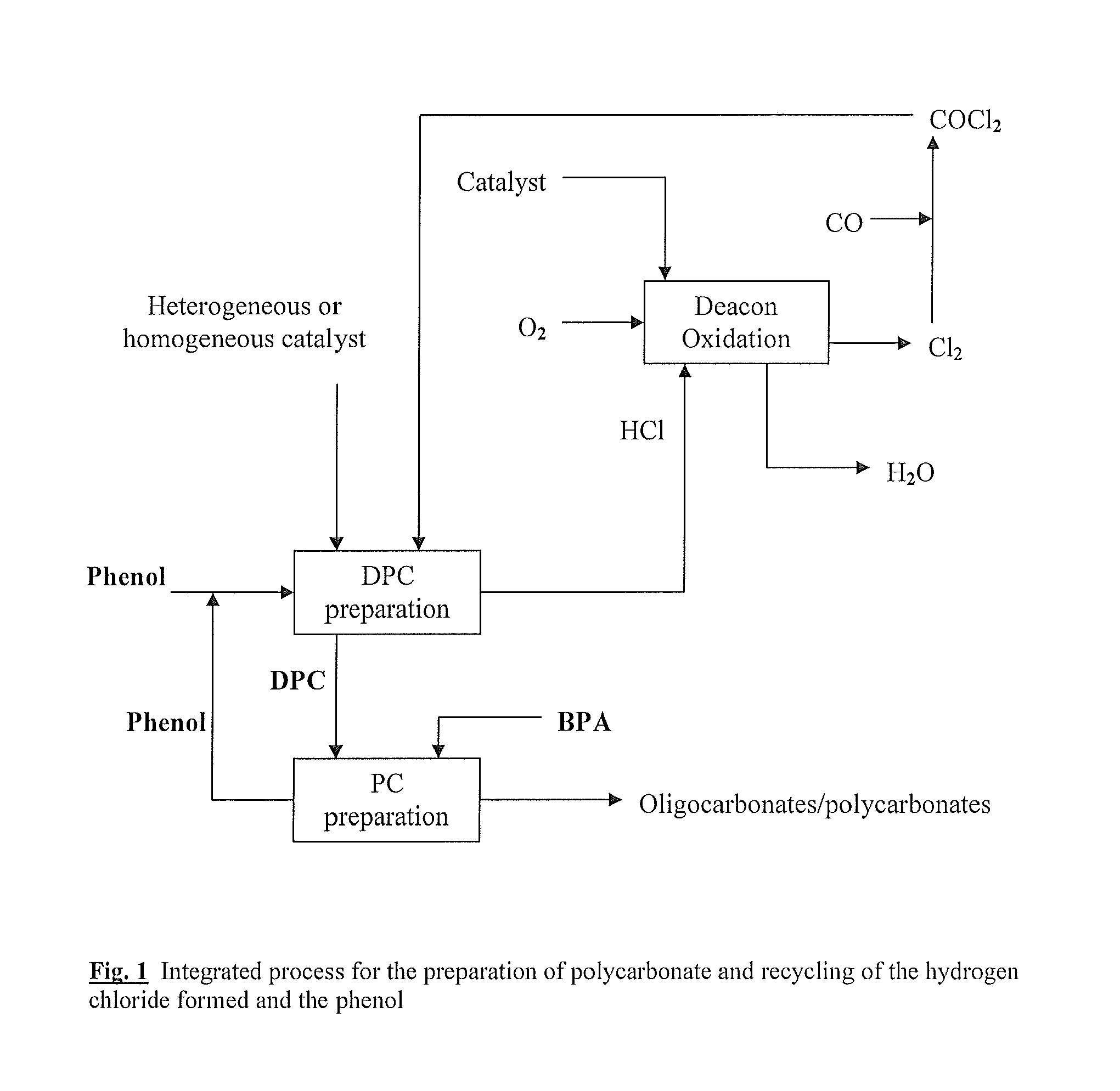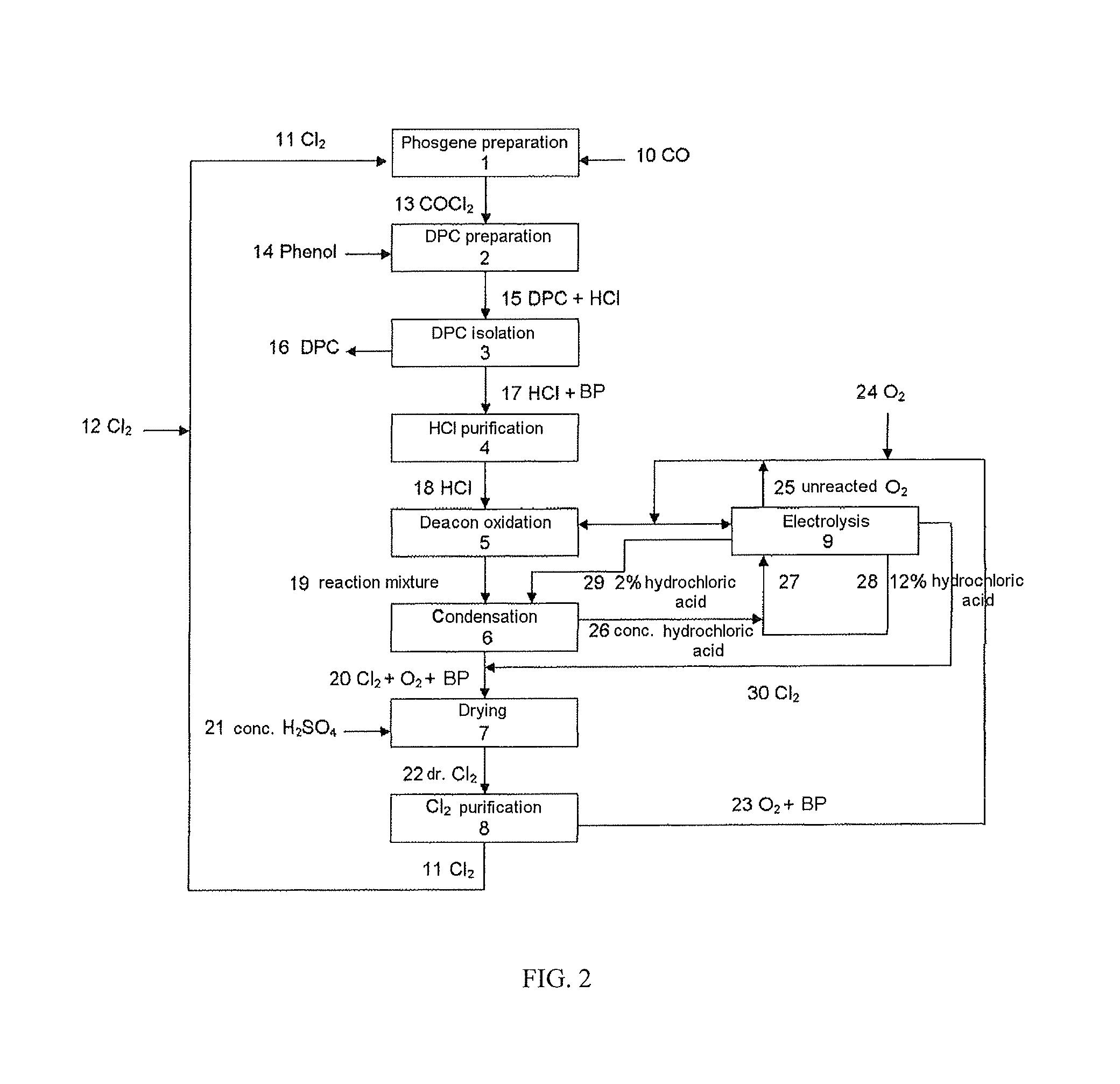Process for preparing diaryl carbonates and polycarbonates
a diaryl carbonate and polycarbonate technology, applied in the field of diaryl carbonate and polycarbonate preparation, can solve the problems of high reaction temperature, high reaction temperature and risk of decomposition of chloroformic esters, and use of solvents and sodium hydroxid
- Summary
- Abstract
- Description
- Claims
- Application Information
AI Technical Summary
Benefits of technology
Problems solved by technology
Method used
Image
Examples
examples
[0228]The examples illustrate the process of the invention by means of the thermal oxidation of the hydrogen chloride obtained in the preparation of diphenyl carbonate to chlorine, the conversion of the chlorine into phosgene which can be used again in the process for preparing diphenyl carbonate (DPC process) (FIG. 2) with recirculation of the phenol formed in the preparation of polycarbonate to the preparation of diphenyl carbonate (FIG. 1).
[0229]In a first stage 1 of the preparation of diaryl carbonate (FIG. 2), chlorine 11 is reacted with carbon monoxide 10 to form phosgene 13. In the subsequent stage 2, phosgene 13 from stage 1 is reacted with a monophenol 14 (e.g. phenol) to form a mixture 15 of diaryl carbonate (e.g. diphenyl carbonate, DPC) and hydrogen chloride which is separated in stage 3 into diaryl carbonate 16, which is utilized, and HCl gas 17, which is subjected to a purification 4. The purified HCl gas 18 is reacted with oxygen in the HCl oxidation process 5, here i...
examples 1a-h
Preparation of Diphenyl Carbonate by Direct Phosgenation of Phenol
1a) Diphenyl Carbonate by Phosgenation of Phenol in the Presence of γ-Al2O3
[0241]The apparatus used for carrying out the process of the invention and the streams involved are shown schematically in FIG. 3.
[0242]41.12 parts by weight / h of phenol 1, fresh and / or recovered from the preparation of polycarbonate as described in Example 3) are taken from a heated vessel I and fed via heat exchanger III (60° C.) under atmospheric pressure from the top into a packed countercurrent column VII which is heated to 60° C. and in which mixing with phenol 14 taken from the top of the distillation column X takes place. After the offgas stream 15 originating from the degassing apparatus VI and IX has flowed through VII, mixture 11 (weight ratio of phenol / phosgene about 97 / 3) is fed in at the bottom. From storage tank II 21.93 parts by weight / h of phosgene 3 preheated by means of heat exchanger IV (170° C.) are introduced together wit...
examples 2a-b
Recycling of Hydrogen Chloride from the Preparation of Diphenyl Carbonate by Thermal Oxidation by Means of Oxygen and Electrolysis
2a) Recycling of Hydrogen Chloride from the Preparation of Diphenyl Carbonate by Thermal Oxidation by Means of Oxygen in Combination with an Electrolysis Using an Oxygen-Consuming Cathode
[0268]A stream of 35.9 parts by weight / h of purified hydrogen chloride from a preparation of diaryl carbonate is divided into two substreams. 29.5 parts by weight / h are fed to an HCl oxidation and 6.4 parts by weight / h are fed to an HCl absorption. 29.5 parts by weight / h of HCl are fed together with 12.9 parts by weight / h of oxygen (content greater than 99%) to a catalytic HCl oxidation. The oxidation is carried out at 333° C. and 3.4 bar. The HCl conversion in the reactor is 85%. The gas mixture leaving the reactor is cooled to 100° C. and the HCl is condensed together with the water of reaction in an HCl absorption. For this purpose, a substream of the anolyte acid stre...
PUM
| Property | Measurement | Unit |
|---|---|---|
| pressure | aaaaa | aaaaa |
| pressure | aaaaa | aaaaa |
| temperature | aaaaa | aaaaa |
Abstract
Description
Claims
Application Information
 Login to View More
Login to View More - R&D
- Intellectual Property
- Life Sciences
- Materials
- Tech Scout
- Unparalleled Data Quality
- Higher Quality Content
- 60% Fewer Hallucinations
Browse by: Latest US Patents, China's latest patents, Technical Efficacy Thesaurus, Application Domain, Technology Topic, Popular Technical Reports.
© 2025 PatSnap. All rights reserved.Legal|Privacy policy|Modern Slavery Act Transparency Statement|Sitemap|About US| Contact US: help@patsnap.com



